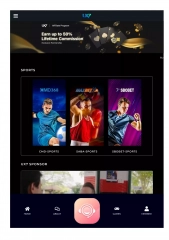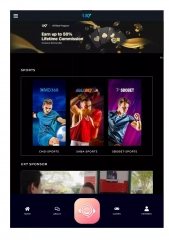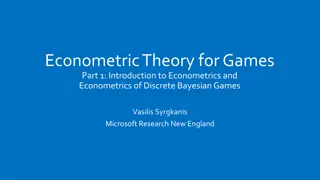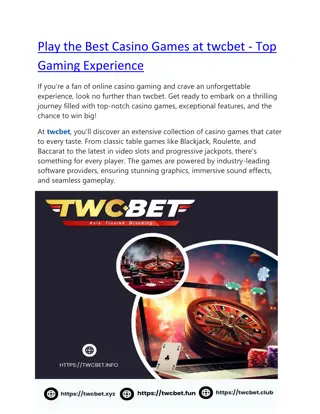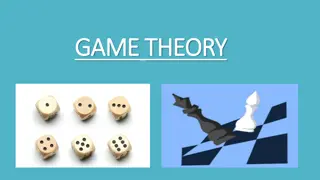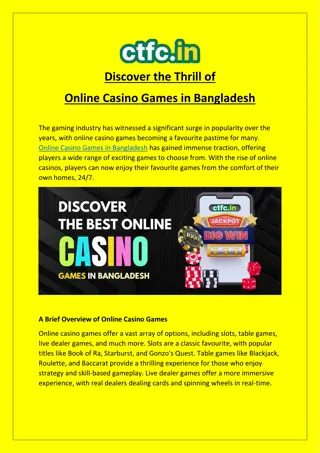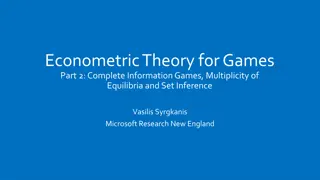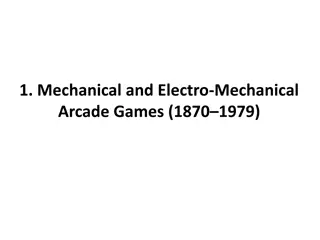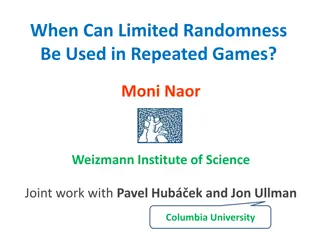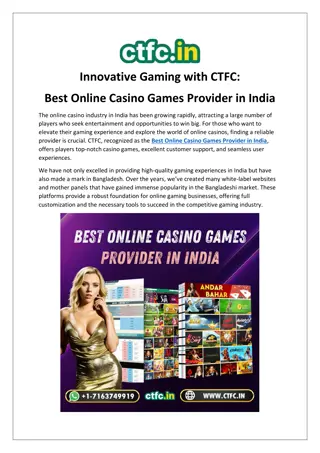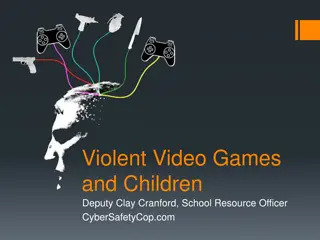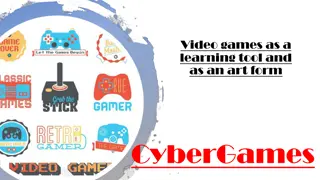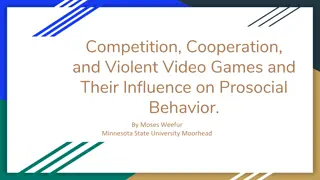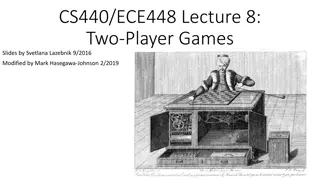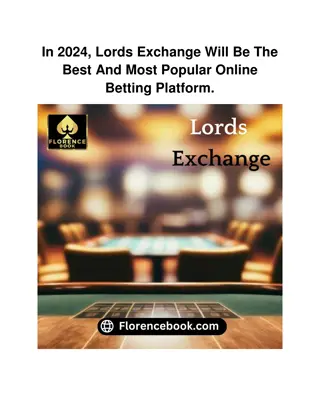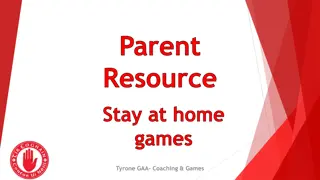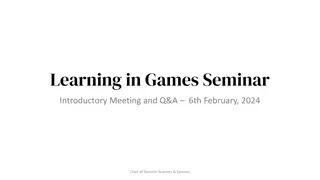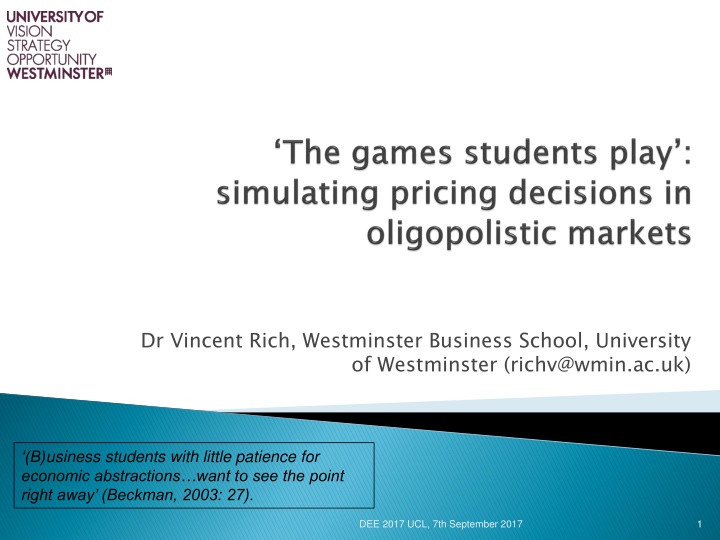
Exploring Pricing Decisions in Oligopolistic Markets Through Business Simulations
Dive into the world of oligopolistic markets through interactive business simulations where student teams make strategic pricing decisions. Learn how these simulations enhance critical thinking, problem-solving skills, and collaborative learning. Discover the history and benefits of using role-play and game-based learning in understanding economic concepts. This exploration is part of a core module for Business Management students at Westminster Business School, University of Westminster.
Download Presentation

Please find below an Image/Link to download the presentation.
The content on the website is provided AS IS for your information and personal use only. It may not be sold, licensed, or shared on other websites without obtaining consent from the author. If you encounter any issues during the download, it is possible that the publisher has removed the file from their server.
You are allowed to download the files provided on this website for personal or commercial use, subject to the condition that they are used lawfully. All files are the property of their respective owners.
The content on the website is provided AS IS for your information and personal use only. It may not be sold, licensed, or shared on other websites without obtaining consent from the author.
E N D
Presentation Transcript
Dr Vincent Rich, Westminster Business School, University of Westminster (richv@wmin.ac.uk) (B)usiness students with little patience for economic abstractions want to see the point right away (Beckman, 2003: 27). DEE 2017 UCL, 7th September 2017 1
This presentation examines pricing decisions made by student teams each playing the part of a company operating in an oligopolistic market, as part of a semester- long, web-based business simulation game . The aim is to explore how far student teams (intuitively) use price as a strategic variable and whether this tends to result in price stability (and convergence) or instability. DEE 2017 UCL, 7th September 2017 2
On-line simulations, including games, reportedly offer more effective learning experiences because they are interactive, engaging and immersive (Ulicsak & Williamson, 2010), enhancing participants critical thinking and creativity. They enable students to reflect on their knowledge and to integrate their learning in an environment that enables them to solve problems and work collaboratively (Sutcliffe, 2002: 40), potentially deepening conceptual understanding. However, the competitive dynamic of games where teams compete and are ranked according to performance needs to be managed properly, to ensure learning is enhanced. In this respect, it is crucial that assessment focuses on students reflection on their experience ,rather than performance in the simulation (Sutcliffe, 2002: 22) Two words of caution for tutors (i) be willing to relinquish control over the learning process and to embrace unexpected outcomes; (ii) ensure that students do not see the game as a break from learning, but rather an intrinsic part of it. DEE 2017 UCL, 7th September 2017 3
The idea of role-play/student interaction to support active learning using prisoners dilemma games to model oligopoly markets dates back more than 50 years (Joseph, 1965). He used face-to-face interaction between groups of three students who competed against each other. Others (see Brouhle, 2011, for a useful summary) have varied the number of players, the form/nature of the interaction (both in- class and web-based), the information available, or duration of the game (within a single class, over multiple days etc). Beckman (2003) used a series two-person games with decisions recorded on spreadsheets to provide business students with intuitive understanding of Cournot and Bertrand behaviour. Sorenson (2002) extended the duration to an entire semester, and included three key features which permitted an escape from the prisoners dilemma: repeated interaction, multimarket contact, and detailed ( fine ) information about firms pricing decisions (p.317) DEE 2017 UCL, 7th September 2017 4
The simulation game forms part of the weekly learning activities (alongside lectures and seminars) on a second year core module (Business Decision Making, or BDM) taken by some 600 Business Management students, across a range of specialisms. Some students may have studied Economics prior to University, but all will certainly have taken an introductory business environment module in their first year with us. For most, their understanding of oligopoly theory at the start of the module is therefore likely to be limited to market form, barriers to entry and the interdependence of firms and the need to take account of rival behaviour. The first three weeks of the BDM module includes a review of Market structure, Porter s Strategic Framework, and simple Prisoner Dilemma-type games. The simulation game allows students to observe the strategies used by fellow teams and then try to adopt effective counter- strategies; this helps to illustrate real-world business behaviour and how price can be used effectively as a decision variable . DEE 2017 UCL, 7th September 2017 5
The companies operate in city markets, with three or four other multi-market companies firms as direct rivals competing for market share, but part of a universe of up to 80 firms with ranking based on Balanced Score Card points. The companies offer the same four products for sale, simultaneously determining the selling price for each one over nine or ten weekly operating rounds (or years , in the company s life). Weekly one-hour workshops, with 40-50 students, although most decisions are taken outside of this, often virtually. There is the possibility of some limited product differentiation due to quality differences (Price only one of a possible range of decisions). Companies submit their decisions once a week. Two or three mock rounds, so students can learn to play the game and model/recognise the impact of their decisions. Information on rival s prices, market demand two rounds ahead and consumer quality preferences can be purchased . The in-module assessment involves a 2,000 word group report, reflecting on the team s performance in the game ; the final ranking counts for up to 10%. The tutor does not control the rules of the game . However, as Brouhle (2011) asserts, the existence of uncertain and diverse outcomes may be helpful in highlighting the range of outcomes that can arise in real-world markets. Ultimately, as Sorenson (2002) rightly points out, although the results of the game s plays are of interest in themselves the primary purpose of the game is pedagogical (317). URL: http://game.edumundo.co.uk DEE 2017 UCL, 7th September 2017 6
1. Quantitative analysis of pricing decisions by individual companies in selected markets to identify patterns of behaviour. This is compared with profit performance and market share. 2. Qualitative elements: (i) an ex-post, in-class survey of a sub-group of individual students reflecting on pricing behaviour; (ii) an analysis of Student Module Evaluations to gauge impact on engagement and learning. DEE 2017 UCL, 7th September 2017 8
Gain market share Undercut rivals Make higher profits Maintain price stability What was the main influence on you choice of product price in the business game? 40% 0% 30% 30% Student Responses Cut prices in line with rivals Keep prices stable, but improve quality Keep prices stable, but choose lower cost supplier Raise prices In the decision game, if rival firms reduced their prices, did you: Student Responses 24% 38% 29% 10% Source: What price success? Pricing decisions in oligopoly markets End of module in-class survey using kahoot.it , April 2017 (n=50) DEE 2017 UCL, 7th September 2017 12
Interactive learning Theory into practice Ability to make decisions as a business Shows what is needed to make a profitable company Insufficient briefing; game not explained properly Limited integration with taught topics/theory Too long What did you most like? (n=35) What did you least like? (n=21) Source: Student Module Evaluation, January 2017; Semester 1; Weeks 7-11; n=211 (48% response) DEE 2017 UCL, 7th September 2017 13
The game offers an opportunity to link theory with practice, in a simulated, but realistic world. Student engagement and interest is good The game involves Bertrand competition, but with incomplete substitutability. Pricing decisions are approached iteratively, with signs that teams react to rival behaviour; there is evidence of both price convergence and divergence. There is no evidence of tacit collusion or cooperation although it is not precluded. However, contrary to their stated behaviour, students appear to learn during the game that higher market prices are associated with higher profits and behave accordingly. DEE 2017 UCL, 7th September 2017 14
Beckman, S R, (2003), Cournot and Bertrand Games, The Journal of Economic Education, 34:1, 27-35. Brouhle, K, (2011), Exploring Strategic Behavior in an Oligopoly Market Using Classroom Clickers , The Journal of Economic Education, 42:4, 395-404. Engelhardt, L M, (2015), Simulating Price-Taking , The Journal of Economic Education, 46:4, 430-439. Greco, M, Baldissin, N & Nonino, F, (2013), An Exploratory Taxonomy of Business Games , Simulation and Gaming, 44:5, 645-682. Joseph, M, (1965), Role playing in teaching economics;, American Economic Review, 55: 1,556-565. Meister, J P, (1999), Oligopoly An In-Class Economic Game , The Journal of Economic Education, 30:4, 383-391. Ryan, M P & Doyle-Portillo, S M, (2014), Do student responses parallel theory? Evidence from an oligopoly experiment , International Review of Economics Education, 17, 66-73. Sorenson, T L, (2002), Theory and Practice in the Classroom: a repeated game of multimarket oligopoly , Contemporary Economic Policy, 20:3, 316-329. Sutcliffe, M (2002), Simulations, Games and Role-play , The Handbook for Economics Lecturers, Economics Network (last accessed 29th August 2017, via https://www.economicsnetwork.ac.uk/handbook/games/) Ulicsak, M. and Williamson, B. (2010). Computer Games and Learning. (Futurelab Handbook). Bristol: Futurelab. DEE 2017 UCL, 7th September 2017 15

